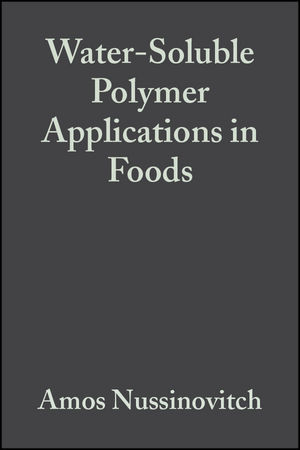Water-Soluble Polymer Applications in FoodsISBN: 978-0-632-05429-9
Hardcover
240 pages
May 2003, Wiley-Blackwell
 This is a Print-on-Demand title. It will be printed specifically to fill your order. Please allow an additional 15-20 days delivery time. The book is not returnable.
|
||||||
Preface viii
Acknowledgements xi
About the Author xii
1 Hydrocolloid Adhesives 1
1.1 Introduction 1
1.2 Mechanical testing of adhesive joints 1
1.3 Hydrocolloids as adhesive materials in foods 4
1.4 Multi-layered gels and texturized fruits 10
1.5 Other uses and future prospects 25
1.6 References 26
2 Hydrocolloid Coatings 29
2.1 Introduction 29
2.2 Edible packaging materials – a general approach 30
2.3 Uses of hydrocolloid for coating 30
2.4 Special biopolymer-based coatings 40
2.5 Special uses and aspects of hydrocolloid films 47
2.6 Film-application techniques 52
2.7 Physical methods and relevant parameters before, during and after coating application 53
2.8 Plasticizers 59
2.9 Drying of films 59
2.10 Gloss properties of hydrocolloid films 60
2.11 References 60
3 Dry Macro- and Liquid-Core Hydrocolloid Capsules 70
3.1 Introduction 70
3.2 Soft gelatin capsules 70
3.3 Liquid-core capsules 71
3.4 Liquid-core hydrocolloid oil capsules 74
3.5 Biotechnological applications of liquid-core capsules 76
3.6 Special food applications 76
3.7 Dry hydrocolloid capsules 78
3.8 References 80
4 Multi-Layered Hydrocolloid Products 82
4.1 Introduction 82
4.2 Deformability modulus and compressive deformabilities of multi-layered gels and texturized fruits 82
4.3 Other multi-layered edible hydrocolloid products 85
4.4 Layered cellular solids 86
4.5 Biotechnological uses of multi-layered gels 88
4.6 Techniques to evaluate properties of multi-layered products 89
4.7 References 90
5 Hydrocolloids in Flavor Encapsulation 93
5.1 Introduction 93
5.2 Spray-drying for flavor encapsulation 93
5.3 Extrusion processes for flavor encapsulation 94
5.4 Film performance in flavor encapsulation 95
5.5 Materials for flavor encapsulation 96
5.6 Flavor oxidation, retention and shelf-life 99
5.7 Controlled release of active ingredients 101
5.8 Food applications 101
5.9 Interactions between volatile compounds and hydrocolloids 108
5.10 Micro-capsules micro-structure 108
5.11 References 109
6 Immobilization for Food and Biotechnological Purposes 114
6.1 Definition, aims and features of immobilized preparations 114
6.2 Immobilization media and techniques 115
6.3 Mechanical properties of immobilization matrices 122
6.4 Mixed systems for immobilization 125
6.5 Food and biotechnological uses of immobilization 126
6.6 Factors related to bead manufacturing 141
6.7 Bead size, sphericity and pore-size measurements of hydrocolloid beads 142
6.8 References 143
7 Texturization of Vegetative Materials 152
7.1 Introduction 152
7.2 Agar and alginate-based texturized fruits 152
7.3 Dependence of composite fruit products on pulp properties 154
7.4 Combined effect of fruit pulp, sugar and gum on texturized fruit products 156
7.5 Alginate texturization of highly acidic fruit pulps and juices 158
7.6 Succulent, hydrocolloid-based, texturized fruit products 159
7.7 Multi-layered texturized fruits 163
7.8 Texturized products for process evaluation 164
7.9 Special products related to texturization of vegetative materials 165
7.10 Texturized vegetative products based on carrageenan, starch, CMC and konjak mannan 165
7.11 Unique uses of texturization 166
7.12 References 169
8 Hydrocolloid Cellular Solids 172
8.1 Introduction 172
8.2 General applications of cellular solids 172
8.3 Structure of cellular solids 173
8.4 Edible cellular solids 173
8.5 Compression of cellular solids 174
8.6 Models for describing stress-strain behavior 175
8.7 Elastic properties of edible cellular materials 177
8.8 Layered sponges and compressibility of spongy particulates 178
8.9 Brittle foams 178
8.10 Hydrocolloid cellular sponges 179
8.11 References 192
9 Hydrocolloids in the Production of Special Textures 196
9.1 Introduction 196
9.2 Fabricated foods 196
9.3 Japanese desserts and molded products 198
9.4 Use of hydrocolloids in spray-dried products 199
9.5 Frozen products 200
9.6 Stabilization and stable foams 202
9.7 Candies 203
9.8 Fluid and emulsion gels 204
9.9 References 205
Abbreviations 207
Index 209



